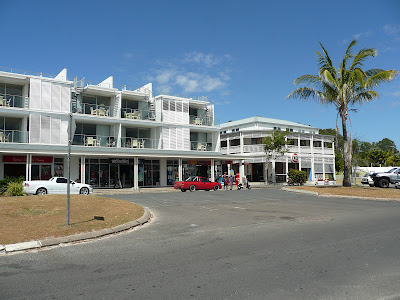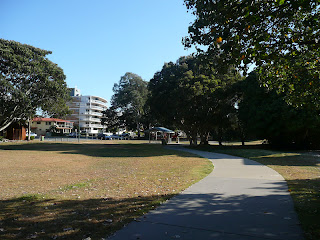Our departure from Golden Beach was something to which I had not been entirely looking forward. Despite the assurances from the park manager that we could easily slide out past the lamp post which was a feature of the front corner of our site, I was somewhat sceptical of his confidence. He knows his job! Like a liner leaving the dock we sailed majestically (and very slowly) onto the park roadway, of the park and thence into the Caloundra traffic as we headed off south yet again.
We had decided to make Murwillumbah, a small town some 15 kms off the Pacific Highway in the Tweed Valley, our afternoon destination for no real reasons other than we had never been there before and it was in the target travelling distance range (and advertised drive-through sites...a boon when merely overnighting).
The view to the south along the approach road is dominated by Mount Warning. Like the Glasshouse Mountains, this is another volcanic plug of rock so hard that it has survived the weathering process which has eroded all around it. Even in the distant haze, it is a very impressive sight.
The Mount Warning volcano is believed to have last erupted some 23 million years ago. Since then the crater has collapsed to form a large caldera which surrounds the mountain. A number of the norther NSW rivers, including the Tweed, have their headwaters around this caldera. The peak was named by Cook during his voyage up the east coast. Shortly after sighting the mountain, he was forced to navigate rapidly to the east to avoid the shallow coastal reefs which lie just off what is now called Final Head (many believe that Cook actually named this Point Danger which makes absolute sense to me). From Cook's perspective, a sighting of Mount Warning provided mariners with ample opportunity to change course at an appropriate time, hence the name.
But enough of the geography and history lesson. Murwillumbah awaits, and what a treat lay in store for the Mobile Marshies at the Greenhills Caravan Park. A drive-through site indeed.....it was a veritable paddock, shaded by huge trees and overlooking cane fields and woodland. Even this shot does not do real justice to the area.
In fact the entire park was open, well grassed and studded with, and surrounded by, large shade trees. A real find, and with what we later saw (briefly) of the delightful Tweed Valley, this is a park we shall undoubtedly revisit.
Paradoxically, even though this site was the biggest we have ever seen, with no need whatsoever to unhitch, we had decided as we drove into Murwillumbah that the town looked so interesting we just had to explore....given the park was 3 kms beyond the town centre, unhitch we did.
It was well worth the effort. What an interesting town. The legendary Nimbin of the flower power era of the 70's and early 80's is a mere 40kms or so away, and I have to say that there are significant remaining examples of those times to be seen in Murwillumbah. Apart from the many locals whose attire and hairstyles transported your correspondent immediately back to his undercover drug squad days, many of the commercial premises in the main shopping precinct offered what could only be described as 'alternative' services.
Main street Murwillumbah could best be described as quaint. In fact, sections of 'old Murwillumbah' reminded me of Scotland for reasons I cannot fully explain...gut feeling I guess.
Many local houses cling to the densely forested hills which surround parts of the CBD
in which we found a number of curios, including this backstreet overpass, something I've not seen for many years,
Main street Murwillumbah could best be described as quaint. In fact, sections of 'old Murwillumbah' reminded me of Scotland for reasons I cannot fully explain...gut feeling I guess.
Many local houses cling to the densely forested hills which surround parts of the CBD
in which we found a number of curios, including this backstreet overpass, something I've not seen for many years,
and this gem of the 50's and 60's, the 'Austral Cafe', which was unfortunately closed for a private function. And there we were just hanging out for a strawberry spider and a chocolate double malted!

And now for the Murwillumbah 'quirky'. But three doors distant from the Austral we came across a pub on which this notice was posted. Now we have no idea what the standards are beyond the front door, but I have to say had we had more time, I would have had a beer or two in here just to reward the publican's sense of humour. (apologies for the reflections)
Here at last I had found a town where I would welcome any of Liz's forays to the shops which I feel sure would be much shorter than usual if I were happily ensconced in this fine 'day care centre' for the duration!
Speaking of pubs, Murwillumbah, which is the centre of a thriving cane industry (I know... I did promise no more sugar cane but needs must), hosts many, the finest of which is indeed a splendid building albeit a little garish. (would not have been out of place in Normanton)
The town sits on the banks of the mighty Tweed River, some portions of which are given over to lovely parks and gardens
in which a careful search may reveal an exotic bird or two. (she was actually looking at a local map before we headed over the bridge and into the town centre from the nearby information centre)
And this area of the park houses a BBQ shelter which I thought was decorated just as it should be in this part of the world.
The banks of the Tweed are dotted with many holiday homes and permanent residences, particularly on the southern side of town. We were particularly taken by the setting of the local YCA Hostel. What a place in which to drop one's backpack for a few days.
But like all the great eastern coast rivers, the Tweed has its darker side. Most of these rivers have huge catchment areas in the order of many thousands of square kilometres, so, as you would expect, heavy rains can create havoc as the rivers burst their banks. Murwillumbah has seen its fare share of inundation, a phenomenon which has now been largely prevented by the erection of a massive levee wall, which starts here and runs for a considerable distance north along the roadway.
As we had, by now, come to expect in Murwillumbah, the local decorators had been at work to significantly beautify what would otherwise be a grey concrete mass. The various local nature themes presented along this levee wall were beautifully done and a were great advertisement for what is on offer in the district. Clever stuff.
And what a district it is. As I have mentioned previously, our visit to the town, and in particular the Information Centre, has whetted our appetites to see much more of the beautiful Tweed Valley and its surrounds. Let me leave Murwillumbah with a parting view of a small sample of what the countryside offers.
Maclean was our planned destination for the following day's trip. We made our way back to the Pacific Highway and continued south

into an ever changing topography. Gone now were the cane fields (promise...promise) as we entered the world of hills and valleys
and the lands of the macadamia and banana plantations.
En route to Grafton we passed though an area which was very familiar to us both and, I am sure, to Mum and Harry. A small nostalgic pictorial offering for the folks at home!
Now back to travel plans for the day. Note 'plannned'. We had previously visited Maclean, this 'Scottish Town in Australia' when staying in Iluka three years ago, to cast an absentee vote of all things (the polling booth in Iluka was somewhat challenged in this regard which we found particularly odd given that it is a real tourist mecca). In any event, apart from the novelty of seeing all the light poles painted in the colours of a myriad of clan tartan colours, the town itself is really charming. Just the spot for an overnight stop and a wander.

into an ever changing topography. Gone now were the cane fields (promise...promise) as we entered the world of hills and valleys
and the lands of the macadamia and banana plantations.
En route to Grafton we passed though an area which was very familiar to us both and, I am sure, to Mum and Harry. A small nostalgic pictorial offering for the folks at home!
Now back to travel plans for the day. Note 'plannned'. We had previously visited Maclean, this 'Scottish Town in Australia' when staying in Iluka three years ago, to cast an absentee vote of all things (the polling booth in Iluka was somewhat challenged in this regard which we found particularly odd given that it is a real tourist mecca). In any event, apart from the novelty of seeing all the light poles painted in the colours of a myriad of clan tartan colours, the town itself is really charming. Just the spot for an overnight stop and a wander.
Enter plan 'B'. The caravan park in Maclean is so small that we would not have been able to manoeuvre our rig through the entrance driveway let alone access our 'drive-through' site. They were minuscule. "Let's try Grafton". A trawl through the caravan parks book, a 'fingers crossed' choice, and a phone call saw us booked in to the Glenwood Tourist Park and Motel in south Grafton, a locale which boasted serenity and large, drive-though sites.
Another find! The park provided exactly what had been promised with the bonus that the couple who had recently bought the place and were very much in the throes of rejuvenating it, were absolutely charming and most helpful. Sadly the grassed areas were struggling with a lack of winter rain and the fact that water restrictions had obviously limited the degree to which this could be overcome, but apart from that we were more than happy with our camp, here seen in the early morning mists of the following day.
Despite the fact that we have never visited Grafton itself, and, from what we had learnt, there is much on offer in this historic town, we decided that we had had enough for this day. The tug remained hitched and we settled into a late afternoon happy hour before a fine evening meal and early night. Sawtell beckoned....the second of our two current favourite destinations.
Another find! The park provided exactly what had been promised with the bonus that the couple who had recently bought the place and were very much in the throes of rejuvenating it, were absolutely charming and most helpful. Sadly the grassed areas were struggling with a lack of winter rain and the fact that water restrictions had obviously limited the degree to which this could be overcome, but apart from that we were more than happy with our camp, here seen in the early morning mists of the following day.
Despite the fact that we have never visited Grafton itself, and, from what we had learnt, there is much on offer in this historic town, we decided that we had had enough for this day. The tug remained hitched and we settled into a late afternoon happy hour before a fine evening meal and early night. Sawtell beckoned....the second of our two current favourite destinations.




























































